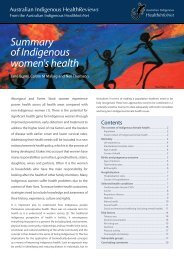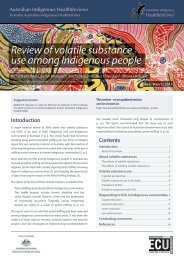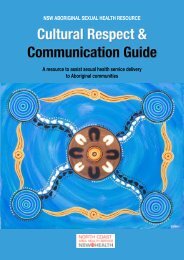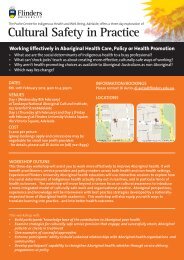hearing loss and the criminal justice system - Australian Indigenous ...
hearing loss and the criminal justice system - Australian Indigenous ...
hearing loss and the criminal justice system - Australian Indigenous ...
You also want an ePaper? Increase the reach of your titles
YUMPU automatically turns print PDFs into web optimized ePapers that Google loves.
Senate Inquiry March 2010_________________________________________________________________________________________________________________Communication in courtFair <strong>and</strong> just outcomes are more difficult within court processes not only because of <strong>the</strong>defendant’s <strong>hearing</strong> <strong>loss</strong> but also because of <strong>the</strong> <strong>hearing</strong> <strong>loss</strong> among <strong>Indigenous</strong> witnesses(Howard, 2006). Hearing <strong>loss</strong> related communication difficulties often interact with cultural<strong>and</strong> linguistic issues, but to date it is only <strong>the</strong> cultural <strong>and</strong> linguistic factors that have beenconsidered in research <strong>and</strong> practice in <strong>the</strong> <strong>justice</strong> <strong>system</strong>. One example is <strong>the</strong> greaterpropensity of <strong>Indigenous</strong> people to have a long silence before responding to questions.“Long periods of silence are generally avoided in mainstream <strong>Australian</strong> discourseexcept among intimate friends or relatives. Particularly in formal proceedings,<strong>the</strong>re is a felt need to ‘fill in’ silent periods. In Aboriginal societies, on <strong>the</strong> o<strong>the</strong>rh<strong>and</strong>, lengthy periods of silence are <strong>the</strong> norm, <strong>and</strong> are expected duringconversation, particularly during information sharing or information‐seeking.(Queensl<strong>and</strong> Government, p 39)Diana Eades describes <strong>the</strong> importance of underst<strong>and</strong>ing this for courtrooms."an Aboriginal woman from central Queensl<strong>and</strong>, who was in prison in Brisbane. Sheasked to give evidence at a Criminal Justice Commission <strong>hearing</strong> in Brisbane in <strong>the</strong>mid 1990s in a case investigating allegations of police wrong doing (in <strong>the</strong>irinvestigation of a crime). This woman had been a witness to certain events shewanted to tell <strong>the</strong> commission about. I was to give evidence later that day aboutAboriginal communication, <strong>and</strong> was asked to listen to evidence of a few of <strong>the</strong>witnesses including this woman.Although it had been she who had approached <strong>the</strong> lawyers, when she took <strong>the</strong>st<strong>and</strong>, she seemed unable to tell her story, or answer <strong>the</strong> questions. Doubtless shefelt some unease in <strong>the</strong> situation, but <strong>the</strong> thing that struck me was <strong>the</strong> fast pace ofquestions, with no time for answers ‐‐ <strong>the</strong> old western anglo thing of feelinguncomfortable after about 1 second silence, <strong>and</strong> <strong>the</strong>n going on to ask <strong>the</strong> nextquestion.The lawyers <strong>and</strong> <strong>the</strong> commissioner were getting frustrated, so <strong>the</strong>y asked <strong>the</strong>witness to step outside while <strong>the</strong>y discussed <strong>the</strong> problem. When <strong>the</strong>y asked for myopinion, I said <strong>the</strong>y needed to allow longer time of silence as <strong>the</strong> first part of <strong>the</strong>answer to <strong>the</strong>ir questions.When asked exactly what <strong>the</strong>y should do, I said, "ask your question <strong>and</strong> <strong>the</strong>n shutup". When asked how long <strong>the</strong>y should wait, I said "till after <strong>the</strong> answer". Thecommissioner directed <strong>the</strong> lawyers to proceed according to my advice <strong>and</strong> <strong>the</strong>witness was brought back in. To <strong>the</strong> lawyers' credit <strong>the</strong>y followed my instructions,<strong>and</strong> <strong>the</strong> transformation in <strong>the</strong> witness was amazing. She did pause noticeablybefore answering some questions, <strong>and</strong> <strong>the</strong>n proceeded to give a very articulate <strong>and</strong>coherent account of what she needed to tell <strong>the</strong> commission. The only differencebetween <strong>the</strong> two sessions of evidence with this woman, was <strong>the</strong> pacing of <strong>the</strong>questions – that is, <strong>the</strong> lawyers allowing for silence as <strong>the</strong> first part of her answers._________________________________________________________________________________________________________________13 Phoenix Consulting








